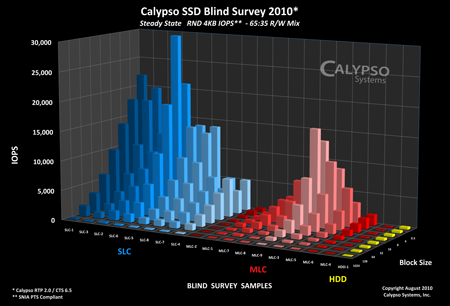The MySQL Conference, a gathering of programmers who share database strategies, was held in the Santa Clara Convention Center this week. One hot topic was SSDs.
My favorite session was hosted by Fusion-io. They rounded up four satisfied customers who discussed how Fusion-io SSDs had benefited them.
Craigslist, found that in their systems the RAID card was their highest point of failure. That doesn’t help much, when the whole point of a RAID system is to prevent failures! Although the company is only halfway through their first SSD deployment, they are recognizing 2/3 power reductions while their tests are running surprisingly faster than they had with RAID systems. SSDs are allowing them to move to two incidences of MySQL on a single server with two IOdrives on each server. Their bottleneck has moved from storage to the software.
Cloudmark, a net security firm that blocks Spam for over 1 billion in-boxes, started with a system that consumed 48U of servers and storage, and their needs ballooned to the point that they were worried they couldn’t keep pace. By adding SSDs they were able to actually reduce their systems to 17U, losing 180 drives along the way. Their processor CPUs are now operating at maximum capacity, something they have never seen before. Cloudmark’s present system runs 22Us of systems with 22 IOdrives operating in a RAID configuration that is significantly cheaper than a SAN. The SAN costs $500K. They have been able to replace this with two servers, each with an IOdrive, for about $20K all told.
Answers.com: The 18th-rated Internet site in the US and 31st worldwide, is a staunch user of HP hardware. When HP announced their support of the IOdrive, Answers.com bought a couple and found that they could avoid the purchase of four additional servers by buying a 320GB Fusion-io drive for the price of about two servers. When they compared performance against their SAS-based systems Answers.com was astounded to get a ten times improvement in complex queries from 350 to 3,500 per second. Restoring the system from backup dropped from over 6 hours to 12½ minutes! CPU loading dropped from 30% to 18%. The company’s old topology had five data centers with four servers per data center. Today a single server per data center does the trick. Their tests indicate that they could reduce the number of servers to 1/9th the original number, but conservative policies prevent them from trying this. The current configuration has been in place for one year, and the company still has more processing power than they need.
Percona is an important MySQL consulting firm, helping clients through system analysis, coding, and even training. Percona ran extensive tests on Fusion-io and Intel mainstream SSDs in comparison with enterprise HDDs and even HDD RAID systems. The conclusion was that the Fusion-io IOdrives were a hands-down winner in database applications.
All in all these four users present an extremely compelling case for SSDs in general, and Fusion-io drives in particular (although we should keep in mind that Fusion-io selected the speakers for this panel.) With the results these firms experienced it’s clear that now is the time for all data center managers to stand up and pay attention!
